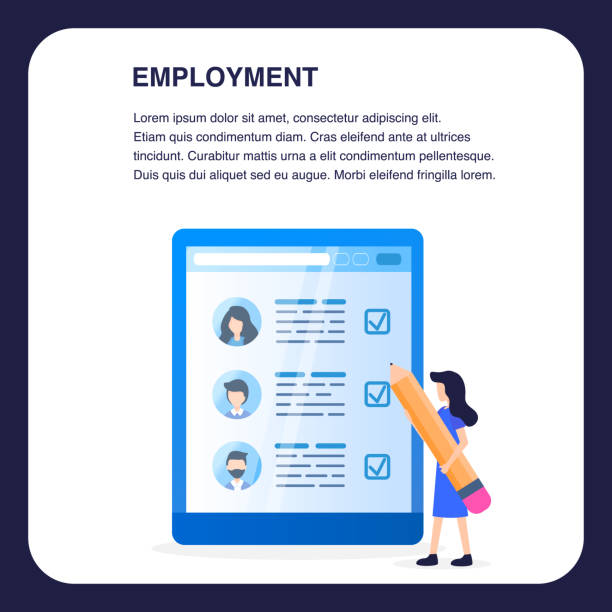Introduction to Responsive Web Design: A Digital Age Imperative

In today’s world, where various devices including mobile phones, tablets, laptops, and smart TVs are used to access the internet, the importance of #responsive_website_design is more apparent than ever.
It’s no longer enough for a website to look good only on a desktop; it must provide a seamless and optimized experience on any screen size.
This approach enables websites to intelligently adapt to different screen dimensions without the need for separate versions for each device.
Simply put, responsive design means your website should take the shape of its container, like water.
This not only contributes to visual appeal but also improves the efficiency and accessibility of the website for various users.
The main goal of #responsive_design is to provide the best possible user experience, regardless of the device the user employs to browse the web.
This concept has transformed the web into a flexible and adaptable space where content is displayed beautifully and with full functionality in any environment, forming the foundation of the modern web.
Did you know 85% of customers review your company’s website before any interaction?
With Rasaweb, build a corporate website worthy of your reputation.
✅ Increase credibility and customer trust
✅ Attract high-quality leads
⚡ Get free website design consultation
Why Responsive Website Design is Crucial for Your Business: A Comprehensive Analysis

Responsive website design is no longer a luxury; it’s a necessity for any business that wants to remain competitive in the online space.
From a commercial perspective, this approach has profound impacts on SEO, conversion rates, and customer experience.
Google and other search engines have explicitly stated that mobile-friendliness is one of the factors for website ranking.
This means if your site is not responsive, you will likely rank lower in search results, and this translates to reduced organic traffic.
Moreover, today’s users have high expectations for websites; if your site doesn’t display correctly on mobile or its navigation is difficult, they will leave immediately.
This high bounce rate means losing potential customers and reducing sales opportunities.
Given the increasing growth of mobile traffic, which accounts for a significant portion of total internet traffic, ignoring responsive design is tantamount to ignoring a large segment of your target market.
Investing in responsive web design is, in fact, an investment in the future of your business and a guarantee of your effective presence in the digital ecosystem.
This is a smart decision for maintaining and expanding your customer base and increasing sales.
Key Principles and Techniques in Responsive Website Design: A Comprehensive Guide

Understanding the principles of responsive website design is the most fundamental step for its successful implementation.
These principles include three main pillars: Fluid Grids, Flexible Images, and Media Queries.
Fluid Grids use relative units like percentages for element widths instead of fixed pixel units, so the website layout can change proportionally with the screen size and adapt well to any device.
Flexible Images, by using CSS properties such as `max-width: 100%` and `height: auto` ensure that images never overflow their container and are always scaled proportionally without losing quality.
But perhaps the most important tool among these is Media Queries.
This CSS feature allows developers to apply different styles based on device characteristics like screen width, orientation (portrait or landscape), or resolution.
For example, you can define a single-column layout for devices with a width less than 768 pixels and a multi-column layout for larger devices.
Using the `<meta name=”viewport” content=”width=device-width, initial-scale=1.0″>` tag in the `<head>` section of the HTML document is also crucial for ensuring proper scaling on mobile devices and controlling the Viewport.
This combination of techniques forms the foundation of a strong and efficient responsive design that prepares your site for the future.
A deep understanding of these concepts is key to building websites that look great and perform flawlessly on any device.
Main Responsive Design Techniques and Their Applications
| Technique | Description | Main Application |
|---|---|---|
| Media Queries | Apply CSS based on device features (e.g., screen width, resolution, orientation). | Dynamically change layout, font, and element sizes. |
| Fluid Grids | Use percentages and relative units (vw, vh) instead of fixed pixels for layout elements. | Adapt layout to different screen dimensions without breakage. |
| Flexible Images | Automatic scaling of images based on available space using CSS. | Prevent images from overflowing and maintain their aspect ratio. |
| Viewport Meta Tag | Control the initial dimensions and scale of the site’s view in mobile browsers. | Ensure correct display and prevent unwanted automatic zooming. |
Responsive Web Design Tools and Frameworks: A Guide to Choosing

To facilitate the responsive website design process, numerous tools and frameworks have been developed to help developers build responsive websites faster and more efficiently.
Among the most popular of these frameworks is Bootstrap.
Bootstrap is a comprehensive collection of CSS, JavaScript, and HTML that includes ready-made templates for designing forms, buttons, navigations, and other UI components, and is designed to be responsive by default.
This framework, with its 12-column grid system, allows designers to quickly create complex and adaptive layouts.
Another framework that has gained attention is Tailwind CSS.
Tailwind is a utility-first CSS framework that enables rapid creation of custom and responsive layouts without restricting you to predefined components, giving you complete control over styling.
For those looking for lighter solutions, frameworks like Foundation or Bulma are also good options, focusing on simplicity and flexibility.
In addition to frameworks, various tools exist for testing and debugging responsive design.
Modern browsers like Chrome and Firefox have developer tools that allow simulating different devices and testing the responsiveness of a site.
Choosing the right framework depends on project complexity, development team preferences, and timeline.
The important thing is to select a tool that helps you deliver a high-quality and optimized responsive web design.
Are you worried about losing customers because you don’t have a professional e-commerce site?
With e-commerce website design by Rasaweb, forget these worries!
✅ Significant increase in sales and conversion rate from visitor to customer
✅ Professional and user-friendly design that builds customer trust
⚡ Get free consultation from Rasaweb
The Impact of Responsive Website Design on SEO and Search Engine Rankings: An Analytical View

The connection between responsive website design and SEO (Search Engine Optimization) is much deeper than many people imagine.
Google has officially announced that ‘mobile-friendliness’ is a ranking factor, and websites that do not provide a suitable user experience on mobile may rank lower in search results.
The reason for this is clear: with the increasing share of mobile searches, search engines aim to provide the best results to their users, and these best results include websites that display correctly on their devices and provide a seamless experience.
Responsive design, by using a single URL and a single HTML code for all devices, avoids the duplicate content issues that occur with separate mobile sites.
This also makes crawling and indexing easier for search engines, as there is no need to crawl and process multiple versions of a page, and server resources are better managed.
Furthermore, site loading speed, another important SEO factor, can be improved by optimizing images and CSS/JS codes in a responsive web design.
A better user experience leads to a lower bounce rate and longer time on site, which also indirectly positively impact SEO rankings.
Overall, responsive website design is a win-win strategy for users and search engines that significantly helps improve your online visibility.
User Experience Benefits of Responsive Website Design: Enjoy Browsing on Any Device

One of the most prominent advantages of responsive website design is the significant improvement in user experience (UX).
In an era where users expect to access information anytime, anywhere, a website that functions seamlessly across mobile, tablet, and desktop can make a big difference in user satisfaction.
Imagine a user browsing your site on their mobile phone on the subway, then continuing their work on their laptop at home; an adaptive site allows them to effortlessly pick up where they left off.
This continuity of experience creates a sense of satisfaction and loyalty in the user, turning them into your permanent customer.
Additionally, easy navigation, clickable buttons that are appropriately sized for touch, readable text, and high-quality images that are correctly scaled are all results of good responsive design.
These factors cause users to be less confused and to interact more with your site, ultimately leading to increased time on site and decreased bounce rates.
Ultimately, a positive user experience leads to increased conversion rates, reduced bounce rates, and increased time spent on the site.
These factors are not only beneficial for users but also directly impact your business goals.
Consequently, investing in responsive website design is, in fact, an investment in the happiness and satisfaction of your users and the sustainable growth of your business.
Challenges and Solutions in Responsive Website Design: A Questioning Dialogue

Although responsive website design offers countless advantages, its implementation is not without challenges, and this can raise many questions.
One of the major challenges is performance management.
How can we ensure that a responsive website loads quickly both on a desktop with high-speed internet and on a mobile with slow internet? Solutions such as image optimization (using next-gen formats like WebP, compression, and lazy loading) and minimizing CSS and JavaScript codes can be helpful.
Another challenge is the complexity of designing for different devices.
Can a single layout truly meet the needs of all devices? In some cases, a ‘Mobile-First’ approach may be needed, where design starts from the smallest screen and then expands to larger ones.
Also, the issue of navigation on small devices arises; hamburger menus are common, but are they always the best solution, and can users easily access them? Additionally, interactive content like forms and maps must be optimized for touch, not just mouse clicks.
How can we ensure a consistent and engaging user experience across all scenarios? These questions require a thoughtful approach and continuous testing to find the best solutions for each responsive web design project to achieve the best results.
Common Challenges and Solutions in Responsive Design
| Challenge | Description | Solution |
|---|---|---|
| Performance and Loading Speed | Large code and image size for small devices and slow internet. | Image optimization (WebP), Lazy Loading, Code compression, CDN. |
| Layout Complexity | Adapting complex layouts to different screen sizes. | Mobile-first approach, using Flexbox and CSS Grid for more precise control. |
| Touch User Experience | Small elements for touch, difficult navigation on touch devices. | Design larger buttons and links, use optimized touch navigation patterns (Swipe, Tap). |
| Large Content and Media | Correct display of videos and galleries on small devices and bandwidth limitations. | Use Responsive Embed, conditional content loading (based on screen size). |
Testing and Optimizing Responsive Website Design: A Crucial Step in Web Development

After the initial implementation of responsive website design, the testing and optimization phase is of particular importance.
Without thorough testing, it’s impossible to ensure that your website functions correctly across all devices and browsers and provides a consistent user experience.
Developer tools in modern browsers like Chrome DevTools and Firefox Developer Tools allow simulating different screen dimensions, changing device orientation, and even simulating internet speed.
These tools are very useful for quickly identifying issues during development and enable you to resolve potential problems before release.
In addition to manual tests, using online tools like Google PageSpeed Insights or Lighthouse is highly recommended for evaluating performance and mobile compatibility.
These tools provide detailed reports on potential issues and suggest solutions, including image optimization, reducing JavaScript execution time, and CSS optimization.
Testing on actual devices, though time-consuming, is the best method to ensure correct functionality, as simulations cannot always cover all details of device behavior.
Continuous optimization includes reducing file sizes, optimizing images, using caching, and minimizing HTTP requests.
These actions not only increase loading speed but also help improve SEO rankings and user satisfaction.
A successful responsive design is the result of an iterative process of development, testing, and optimization that never stops.
Did you know a weak corporate website takes away many opportunities from you daily? Solve this problem forever with professional corporate website design by Rasaweb!
✅ Create a powerful and reliable image for your brand
✅ Attract targeted new customers and increase sales
⚡ [Get free website design consultation]
The Future of Responsive Web Design and Emerging Trends in the Digital World

Responsive website design is constantly evolving, with new trends emerging that shape its future.
One such trend is the advancement in JavaScript and front-end frameworks like React, Vue, and Angular, which enable the creation of Progressive Web Apps (PWAs).
PWAs offer a native-app-like experience in the browser, including offline functionality, push notifications, and installation on the device’s home screen, all inherently responsive and elevating the user experience to a new level.
Another trend is Content-First Design, where content is at the core of the design process, and the layout is then adjusted accordingly.
This approach is particularly crucial for adaptive sites that need to display content across various sizes, ensuring that content always takes precedence.
Also, the use of CSS Grid Layout and Flexbox, instead of heavy frameworks, is increasing.
These native CSS features provide greater flexibility in designing complex and responsive layouts and reduce the need for additional code.
The emergence of new devices such as smartwatches, foldable screens, and augmented reality glasses also means that web designers must be prepared for user scenarios beyond mobile phones and desktops.
Responsive website design in the future will mean adapting to these diverse and ever-changing ecosystems and promises a more inclusive web.
The Importance of Responsive Website Design in Digital Marketing Strategy and Branding

Responsive website design plays a pivotal role in the digital marketing and branding strategies of a business.
A responsive website not only improves accessibility but also strengthens brand credibility and professionalism.
In today’s competitive landscape, where many customers’ first interaction with a brand is via mobile, a poor user experience can quickly lead to a negative brand perception and drive away potential customers.
Conversely, a site that displays beautifully and functionally on any device conveys confidence and assurance to customers, creating a positive brand image.
This is particularly vital for online branding, as the website is often the first point of contact for a customer with the brand.
Furthermore, responsive website design is also efficient in terms of content marketing.
Your content is presented in the best possible way, regardless of the device the user is using, which helps attract and retain an audience and increases engagement rates.
Since online advertising campaigns often direct users to landing pages, ensuring these pages are responsive is crucial for high conversion rates.
A responsive website demonstrates that your business cares about its customers and strives to provide them with the best possible experience, which itself is a strong message for the brand and its values.
Frequently Asked Questions
| Question | Answer |
|---|---|
| What is responsive web design? | A method in web design that ensures websites display well and are usable across various screen sizes (mobile, tablet, desktop). |
| Why is responsive design important? | Due to the increasing use of various devices with different screen sizes (like mobile and tablet) by users to access websites. |
| What are the main technologies used in responsive design? | It uses techniques such as Media Queries in CSS, Flexible Grids, and Flexible Images. |
| What are the benefits of responsive design? | Provides a better user experience on all devices, improves site SEO, reduces maintenance costs (compared to having a separate site for mobile). |
| Is responsive design essential for all websites? | Mostly yes, as it ensures your site is accessible and functional for a wide range of users and the devices they use. |
And other services of Rasaweb Advertising Agency in the field of advertising
- Smart advertising campaign: A dedicated service for growing user engagement based on customizing user experience.
- Smart direct marketing: Designed for businesses seeking digital branding through user experience customization.
- Smart sales automation: A fast and efficient solution for campaign management focusing on marketing automation.
- Smart sales automation: A combination of creativity and technology for campaign management through exclusive programming.
- Smart content strategy: A new service for increasing customer acquisition through exclusive programming.
And more than hundreds of other services in the field of internet advertising, advertising consultation, and organizational solutions
Internet advertising | Advertising strategy | Advertorials
Sources
What is Responsive Web Design?
Principles of User Experience (UX) Design
The Future of Web Development and New Trends
Mobile-First Approach in Website Design
? For the growth and brilliance of your business in the online space, Rasaweb Digital Marketing Agency is with you, offering the best services. To enhance your digital presence and learn more about our solutions, including our professional services in personal website design, visit us.
📍 Tehran, Mirdamad Street, next to Bank Markazi, Southern Kazeroon Alley, Ramin Alley No. 6



